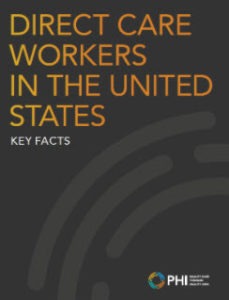Understanding the Challenges Facing Direct Care Workers
 Direct care workers and residential care aides perform physically and emotionally demanding work. Like all workplaces, the residential care workplace has a unique set of challenges for staff. PHI’s newly released report, Direct Care Workers in the United States: Key Facts, highlights some of those challenges. By better understanding the challenges that staff face, a facility can better support staff.
Direct care workers and residential care aides perform physically and emotionally demanding work. Like all workplaces, the residential care workplace has a unique set of challenges for staff. PHI’s newly released report, Direct Care Workers in the United States: Key Facts, highlights some of those challenges. By better understanding the challenges that staff face, a facility can better support staff.
Common Challenges for Direct Care Workers
Understanding the challenges that direct care workers face starts with understanding the workers, themselves. Residential care aides are most often women, people of color, and immigrants, which means they may face discrimination on the job and throughout their lives. Gender and racial equality are major concerns. Additionally, 28% of care aides have a child under age 18, meaning childcare and adequate wages are important.
Residential care aides help to care for 1.1 million residents throughout the United States. Currently, residential care aides face multiple workplace challenges:
- Wage increases have only risen slightly over the past decade. In 2009, median hourly wages adjusted for inflation were $12.27 per hour. Median wages were $12.69 in 2019.
- 25% of residential care aides work part-time. Reasons for that part-time employment include personal obligations, health issues, and the inability to find full-time work.
- 13% of care aides usually work overtime.
- The current median annual income for residential aides is just $21,100, which is a reflection of the low wages and part-time schedules.
The low income leads to other challenges. One in seven residential care aides live in a household that is below the federal poverty line, and 13% of aides do not have health insurance. Housing is another challenge that’s difficult to achieve with low pay. Thirty-four percent of aides do not live in housing that’s considered affordable, meaning that the rent, mortgage payments, and utility bills add up to more than 30% of the household’s income.
Solving Staff Challenges
Focusing on solving staff challenges can help facilities in multiple ways. By addressing these challenges, a facility can improve its ability to attract talented, qualified staff. The residential care industry stands to grow significantly, with approximately 168,400 new jobs predicted to be added from 2018 to 2028. A facility can also improve its reputation as a quality workplace, achieving higher staff satisfaction and improved staff morale by addressing challenges.
The insights of this report highlight the importance of a facility actively working to solve these challenges. Potential steps include:
- Reevaluate existing staff sensitivity trainings to ensure that staff of all cultures and backgrounds feel included
- Revisit the facility’s discrimination policy and ensure that discrimination complaints are investigated
- Provide schedules, including full-time and part-time options, so that caregivers can balance work with other obligations
- When possible, provide overtime opportunities
- Evaluate staff salaries and ensure that gender biases are not occurring
- Reassess budgets and look for opportunities to provide staff with wages and other benefits, including health insurance
There are plenty of other ways to create a positive, supportive staff workplace. Providing staff with bonuses, promotion opportunities, continuing education support, and more can help staff to feel valued and appreciated.
While these study results reflect national results, don’t forget the importance of turning to your staff for insights on how you can help. Anonymous surveys and idea drop boxes can encourage staff to share the benefits and types of support that are most meaningful for them. By keeping that dialogue open, you can identify and implement practices that are most helpful to your employees.

Paige Cerulli is a contributing writer to i Advance Senior Care.
Related Articles
Topics: Facility management , Featured Articles , Resident Care










